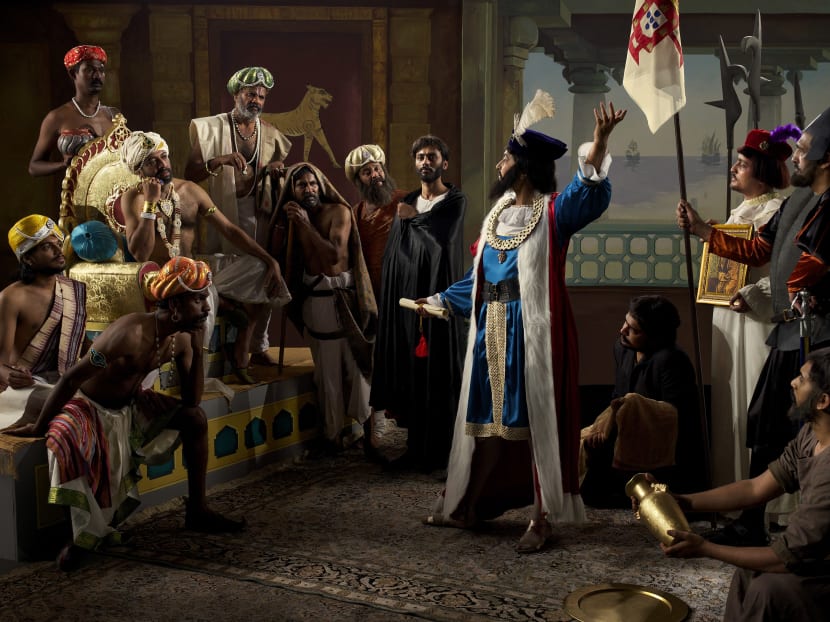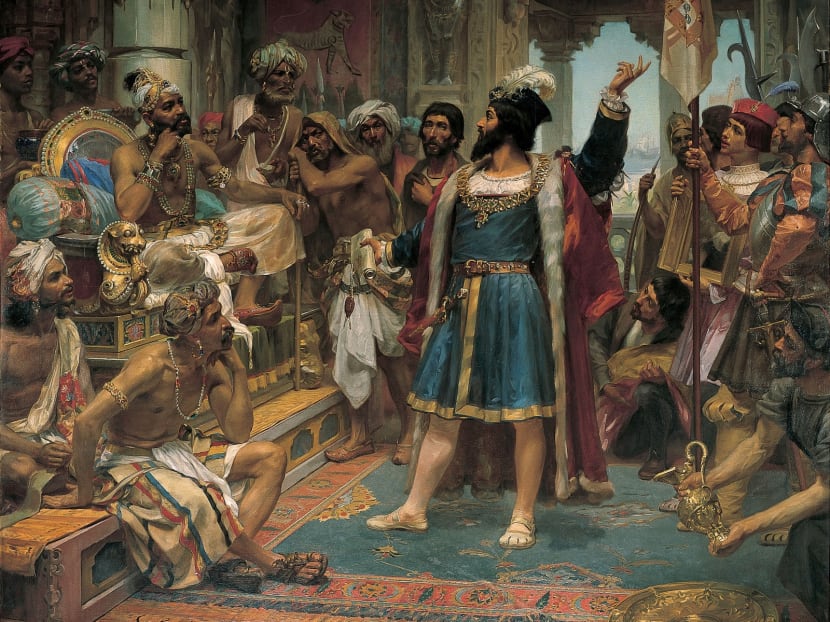The OPEN 2015: India’s Pushpamala N steps inside a painting
SINGAPORE — The harsh images of environmental destruction in Chinese photographer Lu Guang’s exhibition The Price Of Neglect admittedly made for a rather grim start to the Singapore International Festival of Arts’ (SIFA) The OPEN this year. But this week’s second visual art offering sees the mood shifting slightly — from contemporary China, we segue into India’s past with a tongue-in-cheek history lesson courtesy of female Indian artist Pushpamala N, who “steps inside” a painting.


SINGAPORE — The harsh images of environmental destruction in Chinese photographer Lu Guang’s exhibition The Price Of Neglect admittedly made for a rather grim start to the Singapore International Festival of Arts’ (SIFA) The OPEN this year. But this week’s second visual art offering sees the mood shifting slightly — from contemporary China, we segue into India’s past with a tongue-in-cheek history lesson courtesy of female Indian artist Pushpamala N, who “steps inside” a painting.
Opening on Wednesday night at TheatreWorks’ 72-13 space was her installation The Arrival Of Vasco da Gama, which recreates a famous orientalist painting about one of the most pivotal East-meets-West moments in history.
Done in 1898, Portuguese artist Jose Veloso Salgado’s Vasco da Gama Before The Zamorin Of Calicut depicts the Portuguese explorer’s first encounter with the ruler of the ancient Keralan city in 1498. It’s Da Gama’s first pit stop after a journey that sees him get credited as the first European to discover a direct sea route to India, which would eventually open the floodgates for the West’s colonial expansion.
The twist? In the photographic tableau, Indian men take on the roles of Portuguese soldiers and Pushpamala herself dresses up as da Gama, beard and all.
The Bangalore-based sculptor-turned-photographer and video artist has been known for transforming into the central characters of her art projects, similar to the American artist Cindy Sherman. Using the photographic tableau format, she playful appropriates or alludes to a range of things. On Wednesday’s post-exhibition launch talk, for instance, she revealed the process behind creating a previous installation dealing with three overlooked women in the Hindu epic Ramayana.
Images from her work Avega, The Passion riffed off paintings such as The Rape Of The Sabine Women by Nicolas Poussin and Jatayu Vadham by Raja Ravi Varma, one of India’s famous painters from the 19th century. She also took inspiration from the aesthetics of India’s old photography studios, theatre companies and films. (Indeed, one can perhaps also see connections to the artistic processes of artists closer to home: In the photographs of Eugene Soh and Malaysian Wong Hoy Cheong, where classic European artwork are given a local take; Ming Wong’s role-playing/cross-dressing video art; or Ho Tzu Nyen’s Gericault and Delacroix-inspired tableau centrepiece in his EARTH video installation.)
In The Arrival Of Vasco da Gama, you could say Pushpamala’s reimagining of the original Salgado piece is par for the course. After all, Salgado painted it four centuries after the event — plenty of time for him to embellish the moment. The context in which he had painted it is also interesting — in 1898, Portugal was already a declining colonial power. A history painting evoking past triumphs serves the purpose of boosting a nation’s ego at a time when it has some self-esteem issues.
But if the original painting seemingly shouts “We were hotshots once upon a time, you know”, Pushpamala’s installation wags a finger at it and goes “Not so fast.”
A swift retort to both the notion of history paintings and this particular painting’s topic, the Indian artist dismantles conventional notions with a wink. Salgado’s painting of a supposed actual moment is recreated by Pushpamala and her friends as an intricate photographic tableau — that’s printed on canvas, framed and hung on a wall like a proper painting (with TheatreWorks’ reception area painted in dark red to mimic a museum or gallery).
That’s not all: There’s a chalkboard listing down some facts relating to the Portuguese colonial project, such as how the Kerala school of mathematics and astronomy was appropriated later on by Jesuit missionaries, who did not acknowledge where it all came from (apparently, ignoring intellectual property rights is an age-old issue). There’s also a table with drawers overflowing with pepper and cinnamon (a nod to the spice trade), an old globe and a portrait of a monk holding a portrait of Jesus on crucifix.
Incidentally, the latter is one of the many props and backdrops used in the shoot that are now scattered around the space. You also have behind-the-scenes photos of Pushpamala preparing for her transformation (putting on da Gama’s beard) and a smaller photograph of the tableau, probably a sort of dry run minus the fancy costumes.
The visual disconnect of this latter photograph is, personally, more striking than Pushpamala’s final product. And it got me wondering: What is the artist trying to achieve by stepping into the shoes of an erstwhile vanguard of European colonialism even as the final photograph continues to retain the original painting’s politics?
While The Arrival Of Vasco da Gama as an installation does well to dismantle notions of Salgado’s historical painting-as-fact, there’s an ambiguity in the actual centrepiece photograph’s playful, post-colonial critique that doesn’t completely sit well with me.
Ingrained in Salgado’s image is the confrontation between the Zamorin and his court and da Gama and his soldiers. And it’s a mood that Pushpamala retains: While an Indian cast dress up as and take on the roles of the “Portuguese”, the “Indians” are, well, still Indians. And it’s still a face-off.
And in the same way the original painting paints a heroic and noble image of da Gama and skims over what actually happened next (he’s basically humiliated when his gifts don’t impress), the bravado is retained in Pushpamala’s version — minus the tension.
While the image’s post-colonial critique may be muddled, its feminist commentary is not. This is actually the first time Pushpamala has taken on a male role, and her presence in the all-male painting speaks volumes. Framed this way, you could imagine that the more interesting question in the minds of the Zamorin and his Indian sidekicks as they gaze at her isn’t “Who is this white man?” but “Who is this Indian woman?” — as she confidently returns the gaze. (Beneath all that hair, of course.)
On another note, during Pushpamala’s talk, SIFA director Ong Keng Sen mentioned how her work — seemingly a last-minute addition after he chanced upon her at last year’s Kochi Biennale — was more or less the missing piece for this year’s The OPEN. And that’s probably right. You can’t talk about “What Remains After?”, which is the pre-fest fest’s big question, without going into post-colonialism, which is what The Arrival Of Vasco da Gama is exactly about in the most Edward Said-ish way.
But at the same time — and perhaps inadvertently — Pushpamala’s work was a personal reminder that the Indian colonial experience is different from mine. Of course, one should always recognise the overriding general aspects of colonialism (as an imperialist project, for instance), but it’s best to be mindful of the differences between, say, Indonesia’s experience with the Dutch, the Philippines’ with the Americans and Spanish, and even among countries like Myanmar, Singapore and Malaysia under the British.
The Arrival Of Vasco da Gama runs until July 4 at 72-13 Mohamed Sultan Road. Free admission with The OPEN pass with limited single entry tickets available at the door. Closed on Mondays. For more information, visit http://sifa.sg/theopen/








